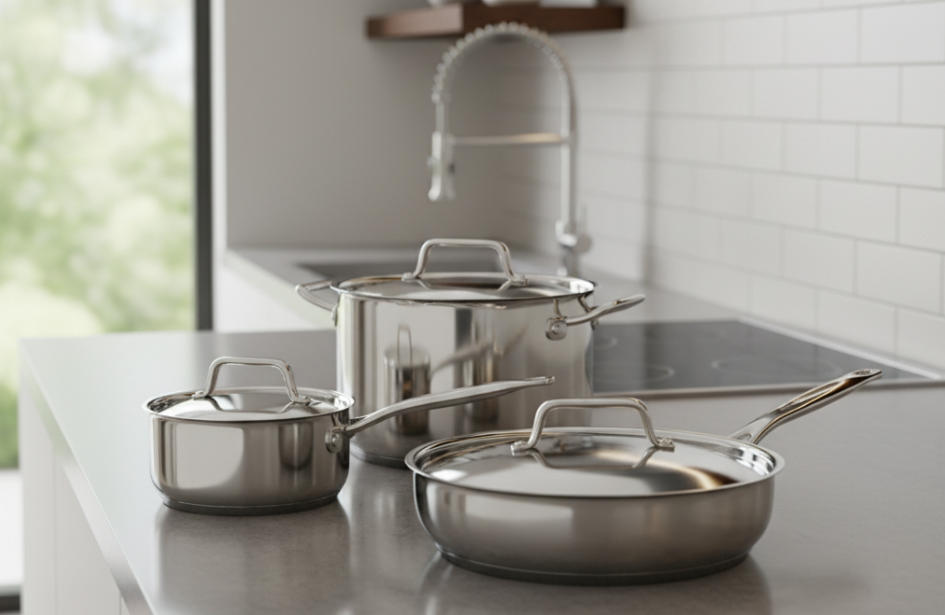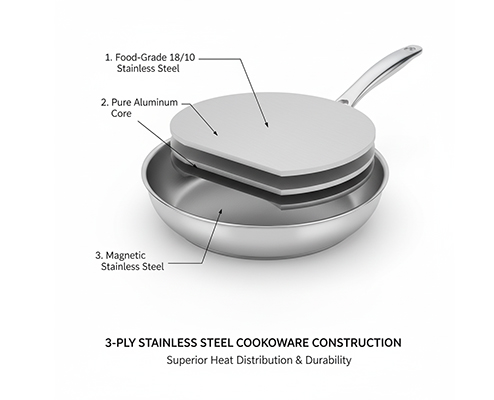Struggling to choose cookware that sells? The wrong inventory sits on shelves, hurting your bottom line. Stainless steel offers a reliable solution that discerning customers actively seek.
Stainless steel cookware's key advantages are its exceptional durability, non-reactive and safe cooking surface, and professional performance. Its main disadvantages include lower heat conductivity on its own and a tendency for food to stick if not used correctly, which quality construction and proper technique can overcome.

As a manufacturer with over 27 years of experience, I’ve seen countless trends come and go. Yet, stainless steel remains a cornerstone for kitchenware importers, wholesalers, and brands. But to sell it effectively, you need to understand both its strengths and its weaknesses from a business perspective. Let’s break down what you, as a professional buyer, truly need to know.
Why Stainless Still Wins in 2025 for Professional Buyers (and When It Doesn’t)?
Market trends are constantly shifting. You need a product line with staying power that doesn't become obsolete overnight. Stainless steel cookware consistently meets this need for a core customer base.
For professional buyers, stainless steel wins because its durability, timeless professional aesthetic, and high performance justify a premium price point. It doesn't win in markets targeting absolute beginners or budget shoppers who prioritize the immediate convenience of non-stick coatings over long-term value.
At INOXICON, we've seen demand for quality stainless steel grow, especially among serious home cooks who are willing to invest in their kitchens. They see it on cooking shows and in restaurant kitchens, and they want that same level of performance and durability. This creates a stable, profitable market segment for your business.
Where Stainless Steel Excels
The appeal of stainless steel is rooted in its tangible benefits, which translate directly into strong selling points for your brand. It represents a long-term investment for the end-user, not a disposable purchase. This perception allows for healthier margins compared to entry-level cookware. Its versatility—from searing a steak to simmering a delicate sauce—makes it an all-in-one solution for experienced cooks.
Where It Faces Challenges
However, stainless steel is not for every consumer. The biggest challenge is user education. Unlike non-stick pans, stainless steel requires preheating and the proper use of cooking fats to prevent food from sticking. Customers seeking effortless, "no-mistake" cooking may initially prefer coated pans. Therefore, your marketing and merchandising must target customers who appreciate quality and are willing to learn simple techniques for incredible results. It’s about positioning it as a tool for culinary excellence.
What are the advantages of stainless steel cookware in terms of performance, safety, and longevity?
Your brand reputation depends on quality. Selling products that fail or disappoint leads to costly returns and bad reviews. Stainless steel offers a trifecta of benefits that builds customer trust.
The primary advantages are its extreme durability, a non-reactive surface that guarantees food safety, and superior heat retention for professional-level searing and browning. It resists rust, chipping, and warping, ensuring it performs for decades.
These three pillars—performance, safety, and longevity—are why we've dedicated our factory to perfecting stainless steel kitchenware since 1997. They aren’t just features; they are promises to the end customer. When you source from a reliable manufacturer, you are sourcing products that uphold these promises, strengthening your brand’s position in the market.
Performance: The Professional's Choice
Stainless steel is prized for its ability to create a perfect sear on meats and vegetables. It excels at browning and allows for "fond" (the tasty browned bits) to develop, which is essential for making flavorful pan sauces. While basic stainless steel isn't a great heat conductor, this is solved with clad construction, where layers of aluminum or copper are sandwiched between stainless steel. This provides the best of all worlds: the fast, even heating of aluminum and the durable, non-reactive surface of steel.
Safety: A Pure Cooking Surface
This is a huge selling point today. Consumers are increasingly worried about the chemicals in non-stick coatings. Stainless steel is inert, meaning it won't react with acidic foods or leach any substances into your meal. It's a pure, safe surface you can count on. It easily meets international food safety standards like FDA and LFGB, simplifying compliance for your import business.
Longevity: An Investment for Life
Stainless steel cookware is incredibly tough. It resists dents, scratches, and corrosion. It can handle high heat in the oven and isn't damaged by metal utensils. This durability means it’s a one-time purchase for many customers, which is a powerful message for value and sustainability.
| Feature | Stainless Steel | Non-Stick (Coated Aluminum) | Cast Iron |
|---|---|---|---|
| Heat Retention | Excellent (especially clad) | Poor to Fair | Excellent |
| Searing Ability | Excellent | Poor | Excellent |
| Food Safety | Excellent (non-reactive) | Good (until coating scratches) | Good (if well-seasoned) |
| Durability | Excellent | Poor (coating wears out) | Excellent (can rust/crack) |
| Maintenance | Low (dishwasher safe) | High (no metal utensils, hand-wash) | High (requires seasoning) |
What are the disadvantages to consider in sourcing & merchandising?
Understanding potential drawbacks is key. If you ignore them, you risk customer complaints and unsold stock. Knowing the challenges helps you prepare your sales and marketing strategy effectively.
The main disadvantages are poor heat conduction in non-clad, single-layer versions and its tendency to have food stick without proper technique. From a business view, higher manufacturing costs and weight can also be challenges.
Over the years, we've helped hundreds of clients navigate these very issues. The solution isn't to hide the disadvantages but to address them head-on through smart sourcing and clear customer education. Choosing the right product construction and providing simple "how-to" guides can turn these weaknesses into opportunities to build trust and demonstrate your brand's expertise.
Addressing Heat Conduction
A cheap, thin, single-layer stainless steel pan will have hot spots and burn food easily. This is the source of many negative reviews. As an importer or brand, the solution is simple: source multi-ply (clad) cookware. A 3-ply construction with an aluminum core is the industry standard for excellent, even heating. By specifying this in your sourcing, you eliminate the single biggest performance complaint before the product ever reaches your customer.
Solving the "Sticking" Problem
Food sticks to stainless steel for two reasons: the pan is too cold, or there isn't enough oil. This is a user-education issue, not a product flaw. Your role is to provide the solution. You can do this by including a small, clear instruction card in the packaging or a "quick tips" section on your product's webpage. Simple instructions like "preheat the pan until a drop of water sizzles" and "add oil and let it shimmer before adding food" transform the user experience from frustrating to fantastic.
Navigating Cost and Weight
Quality stainless steel and clad construction cost more to produce than cheap stamped aluminum. This places the final product at a mid-to-premium price point. It’s not a disadvantage if you are targeting the right market segment. The weight, which adds to shipping costs, also contributes to the premium feel. In merchandising, you can frame the weight as a sign of durability and quality construction.
What should importers know about grades, ply, and set planning?
Sourcing cookware seems complex with all the technical terms. You see "18/10," "3-ply," and "5-ply" but need to know what matters for your business. Making the right choices here defines your product's quality and cost.
Focus on 18/8 or 18/10 stainless steel for food-contact surfaces for corrosion resistance. For performance, 3-ply construction with an aluminum core is the best balance of quality and cost for most markets.

We guide our partners through these technical specifications every day. The goal is to build a product that meets your market's expectations for performance and price. You don't always need the most expensive option; you need the right option. Let's break down the essentials.
Understanding Stainless Steel Grades
The numbers, like 18/10 or 18/8, refer to the percentages of chromium and nickel in the steel.
- 18% Chromium: This provides rust and corrosion resistance. It's the most important number.
- 8% or 10% Nickel: This adds to corrosion resistance and gives the steel its bright, polished shine. 18/10 is considered premium, but 18/8 (also known as 304 grade) is extremely durable and effective for high-quality cookware. For the exterior, a magnetic grade of stainless steel (like 18/0) is often used to ensure induction compatibility.
Choosing the Right "Ply" (Cladding)
"Ply" refers to the number of metal layers bonded together.
- Single-Ply: A single layer of stainless steel. Avoid this for anything other than stockpots or mixing bowls, as it heats unevenly.
- 3-Ply (Tri-Ply): The industry standard. An aluminum core is sandwiched between two layers of stainless steel. It offers excellent heating performance at a great value. This is what we recommend for 90% of our clients.
- 5-Ply or 7-Ply: These have more alternating layers of steel and aluminum/copper. They offer slightly better heat control but at a significantly higher cost. This is best reserved for very high-end, specialized lines.
Smart Set Planning
Don't just sell a generic 12-piece set. Think about what your customers actually use. A well-curated set is often more appealing.
- The Essentials: A 10-inch skillet, a 3-quart saucepan with a lid, and a 6-quart stockpot with a lid. This core set covers most daily cooking tasks.
- Building a Larger Set: Add an 8-inch skillet, a smaller 1.5-quart saucepan, and a large sauté pan with a lid. Consider offering both individual pieces (open stock) and curated sets. This gives customers flexibility and allows them to build their collection over time.
What are the essential use and care tips your customers will ask about?
After the sale, your relationship with the customer continues. Providing clear use and care information reduces returns, builds brand loyalty, and generates positive reviews. Be prepared to answer their most common questions.
The most vital tips are to always preheat the pan before adding oil, use the right amount of oil, and manage the heat properly. For cleaning, deglazing with water on a warm pan works wonders for stuck-on bits.
Empowering your customers with knowledge is one of the best marketing tools you have. When they succeed with your product, they become your brand's best advocates. We always advise our clients to include a simple care guide with their products. Here are the quick answers to the questions you will inevitably receive.
How do I stop food from sticking?
This is the number one question. The answer is simple: Heat the pan first, then add the oil, and then add the food. The pan is ready when a drop of water skitters across the surface without evaporating immediately. Let the oil get hot enough to shimmer before adding your ingredients. Also, let food (especially meat) develop a crust before trying to flip it; it will release on its own.
How do I clean stubborn, burnt-on food?
First, try deglazing. While the pan is still warm, pour in some water or stock. The stuck-on bits will lift right off as you scrape gently with a wooden spoon. For very tough stains, fill the pan with water and a bit of dish soap, bring it to a simmer for a few minutes, then let it cool and scrub. A paste of baking soda and water or a specialized stainless steel cleaner (like Bar Keepers Friend) can remove any remaining discoloration.
Can I use metal utensils?
Yes! This is a major advantage over non-stick. Stainless steel is durable and won't be easily damaged by metal spatulas or whisks.
Is it dishwasher safe?
Yes, high-quality stainless steel cookware is generally dishwasher safe. However, for the best long-term results and to maintain its brilliant shine, hand washing is often recommended.
Conclusion
Stainless steel cookware offers unmatched durability, safety, and performance. Understanding its pros and cons allows you to source smarter, market better, and build a trusted kitchenware brand for years to come.